|
HOW REFRESHING! HOW FRUIT!*
Stuart Campbell was so taken aback
by the universal popular acclaim for his videogame pinball spinoffs
feature in RG45 that by public demand, he’s written one about fruit
machines too.
There are two different basic kinds of
people who read Retro Gamer. Some of you just want to be reminded
nostalgically of happy times spent playing the games of your youth,
while others see the magazine more as a chance to discover games
they missed the first time round and to look at gaming as a timeless
whole in more depth than shallow, hype-obsessed “current” games mags
do. (Which is why RG also covers games which have just been
released, but are “retro” in style rather than by calendar date.)
Viewers in the first group should probably move on to the next
feature right now, because this piece belongs very much in the
latter camp – to this reporter, there’s hardly anything in gaming
more fascinating than an attempt to translate highly distinctive
gameplay values to totally unsuitable-seeming platforms, whether
it’s making a boardgame out of Centipede or converting Tempest to
the ZX81. And there can be few more challenging tasks for a game
designer than bringing an all-action arcade game into the low-tech
money-sucking realm of the fruit machine.

The modern amusement arcade is a very
different place to the one of the golden coin-op era of the 80s and
early 90s. The actual number of arcades hasn’t declined all that
significantly in the last 20 years, and most of them are still in
the same place and look the same on the outside, but where the
interior used to be full of videogames, almost all city-centre
arcades (and even a lot of seaside ones) are now mostly or entirely
populated by no-armed bandits. But the superstars of gaming weren’t
going to be pushed out as easily as that.
We’ve seen in previous
issues of RG how classic videogames have colonised other formats
like board games and pinball tables, and fruit machines (or AWPs as
the arcade industry calls them, standing for Amusement With Prizes)
were to be no different. With vastly varying degrees of success,
coin-op companies have for years been bringing your favourite
videogame stars, like washed-up boxers greeting casino visitors,
into the adult world of gambling. So grab your fake ID, quickly grow
an convincingly manly moustache (you too, ladies), and try to look like your dad as we sneak into this
magical palace of – quite literally! – forbidden fruits, and try not
to get ourselves grabbed by the bouncers. Madam.
-----------------------------------------------------------------------------------------------------------
SPACE INVADERS
For no particular reason, we’re going
to look at videogame fruit machines in roughly the chronological
order of the original games they’re based on, so we start with
what’s actually one of the more recent AWPs to hit arcades –
Crystal’s interpretation of Taito’s seminal Space Invaders. While
we’ll see games later on that are more faithful to their
inspirations, there’s a pretty decent Invaders vibe here, not least
in the shape of the large squadron of space baddies that form the
central feature board. Once you’ve earned your way onto the reel
loop below, you build up Laser Base “lives” to access the feature
board, and moves that allow you to aim at specific invaders on the
board and collect the cash values or features they guard. You can
also shoot down the Mystery Ship to get yourself into the Big Money
bonus area.
The AWP game employs lots sound and
visuals reminiscent of Space Invaders 95 (see The Definitive Space
Invaders in RG issues 41 and 42) to capture the atmosphere of the
1979 original, and much like its monochrome predecessor it’s an
absorbing and tense game which balances risk and reward on a
tantalising knife edge. All fruit machines do that by their very
nature, of course, but it’s rarely put into such sharp relief as it
is here by the constant thud-thud-thud of the trademark Space
Invaders heartbeat - making the two artforms, on this occasion, a
particularly good match for each other.
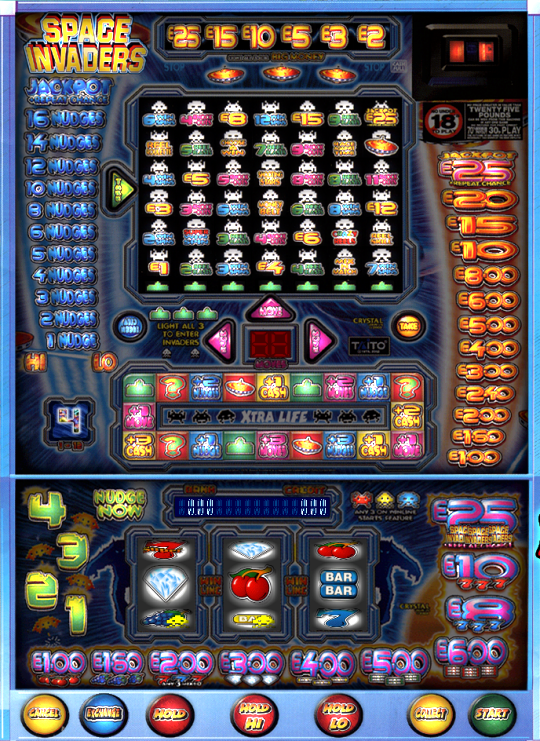
Fans of cheap double
entendres will be delighted (in addition to the “bouncers” joke in
the intro)
to hear that this particular style of gameboard is known in the AWP
industry as a “lapper”.
-----------------------------------------------------------------------------------------------------------
PAC-MAN
Almost 30 years after making his debut,
Pac-Man is still videogaming’s greatest figurehead – or, if you
prefer, videogaming’s biggest tart (and him a married man, too). In
addition to an almost countless number of actual videogames, the
yellow dot-chomper has sold his services to board games, pinballs,
card games, scratchcards, mechanical versions and just about
anything else that you could possibly fit under the banner of
“games”. Of all the many attempts at transferring Pac-Man gameplay
values to other formats, the AWPs are perhaps the least successful
of all, and the first one set the tone.
There’s very little Pac-Man DNA on
display here – the gameboard is simply a makeover of the standard
“double trail game” AWP design of the time, and except for the
traditional Pac-death sound when you land on a ghost or Game Over
square none of the arcade game’s trademark features make an
appearance. It’s a moderately entertaining AWP in its own right, but
a vastly lazy use of the Pac licence and it was briefly the least
impressive of all the videogame fruit machines, until its sequel
came along.
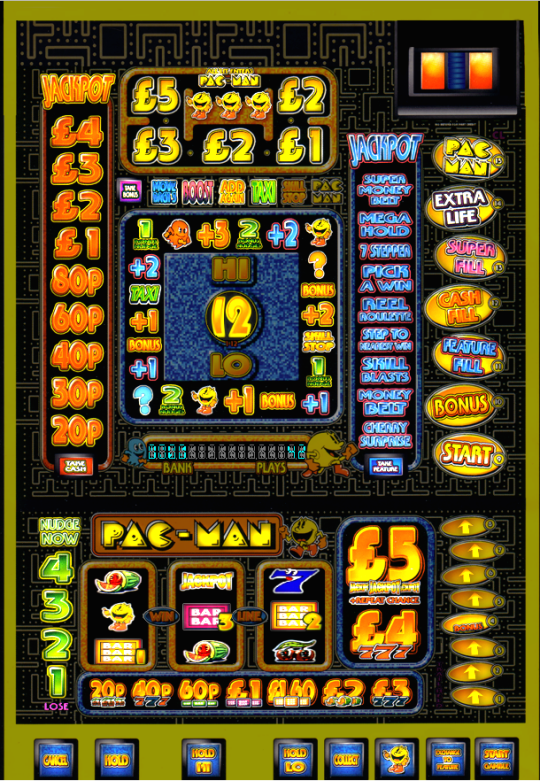
At least there’s been a
half-hearted attempt at depicting some sort of
maze in the background, since the game features no maze elements at
all.
-----------------------------------------------------------------------------------------------------------
PAC-MAN PLUS
Curiously echoing
the name of the most famous bootleg version of the original, the
second attempt at a Pac-Man AWP was barely any different from the
first. Despite moving to a completely different manufacturer (JPM
rather than QPS) and hardware standard, Plus is in most respects
basically the same game as its predecessor. (There's also a slightly
different version by Mazooma.) There’s still the same
trail-based main gameboard, with a second and more lucrative board
which can be reached from the first one, and there are still
multiple types of win trail, although this time you get three rather
than two.
There are lots of
other minor changes, but this is an even poorer translation of
Pac-Man to a fruit machine – there are even fewer authentic sound
effects (the previous AWP’s rudimentary attempt at a “wocka-wocka”
as you travel round the gameboard is now gone, though this time you
do get a cursory blast of the start jingle when you get the
jackpot), and even incredibly tenuous connections to the videogame
such as the ability to earn an extra life have bitten the dust too.
Pac-Man Plus is one of the weakest uses of the licence in history,
and the worst videogame fruit machine “conversion” of all time.
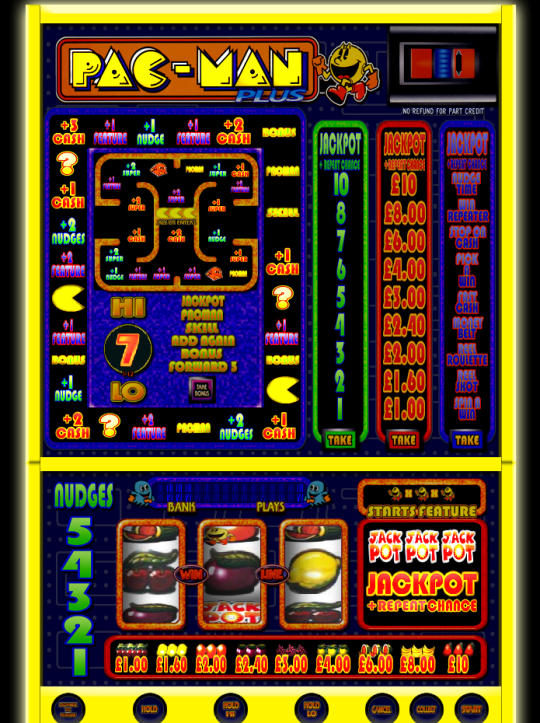
Some artist
was up for literally minutes designing the layout of the Pac-Man
Plus cabinet.
-----------------------------------------------------------------------------------------------------------
DONKEY KONG
Maygay’s AWP
interpretation of Donkey Kong is a much better effort than anything
we’ve looked at so far. Firstly it’s covered in proper DK artwork
(from the Donkey Kong Country era), with Kong and Mario both well represented
and the classic logo both prominently displayed on the top and
bottom glasses and incorporated into play (lighting up the letters
via the reels gets you onto the feature board). More importantly,
though, the action on the gameboard actually feels like playing a
sort of turn-based version of Donkey Kong.
Laid out like the
first stage of the videogame, there are ladders to climb (both full
and broken), barrels to jump (using the hi-lo reel) and even
powerups to collect (pressing the Super Mario button gets you a
one-time bonus, from extra cash or an extra life to opening up the
ladders and letting you zip to the top in half the time). It really
does capture something of the feel of the original arcade game, and the many features and
relatively generous structure make it an unusually enjoyable fruit
machine too.
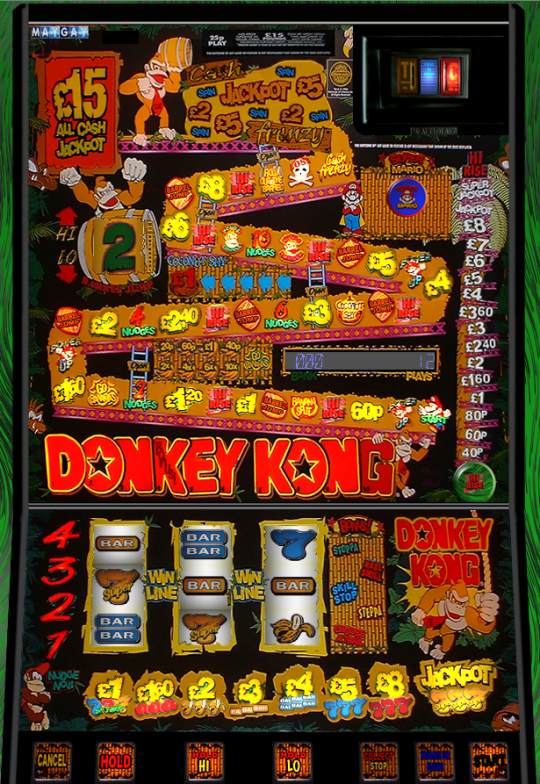
Has it ever
been adequately explained why a giant ape is wearing a huge
groin-length kipper tie?
You’d imagine it could cause terrible asphyxiation hazards while
swinging between treetops.
-----------------------------------------------------------------------------------------------------------
MR DO!
When fruit machines
started having “games” on their upper halves rather than simply
lists of the prizes you could win on the reels, they started out as
simple trail boards, where you progressed along and simply hoped to
avoid the death squares. The first great innovation of the era was
the concept of the “chase” game, where your character would be
pursued by an adversary, and it was into that genre that Mr Do made
one of the videogaming world’s unlikeliest comebacks. (To be fair,
it wasn’t quite as out-of-the-blue as it might seem – the Do! AWP
showed up in the early 90s, during a brief attempt to revive the
brand via a Game Boy remake and Amiga/ST ports of the last coin-op
in the original series, the splendid and excellently-named Do! Run
Run. We don’t talk about the unpleasant pastel-coloured Neo Geo
remake which came along later.)
The Mr Do! Fruit
machine is a tremendous piece of design, both looking and playing
(within the parameters of the format, obviously) like its videogame
counterpart. Pretty much every element of the original makes some
kind of appearance – monsters, cherries, cakes, powerballs,
apple-dropping, multiple routes and even the E-X-T-R-A extra life
feature are all there, and the iconic artwork instantly catches the
eye of any veteran coin-op connoisseur. The machine comes from the
low-jackpot days, so you get plenty of chances to tackle the
gameboard too. It’s a lovely bit of work, and well worth snapping up
if you see one on eBay.
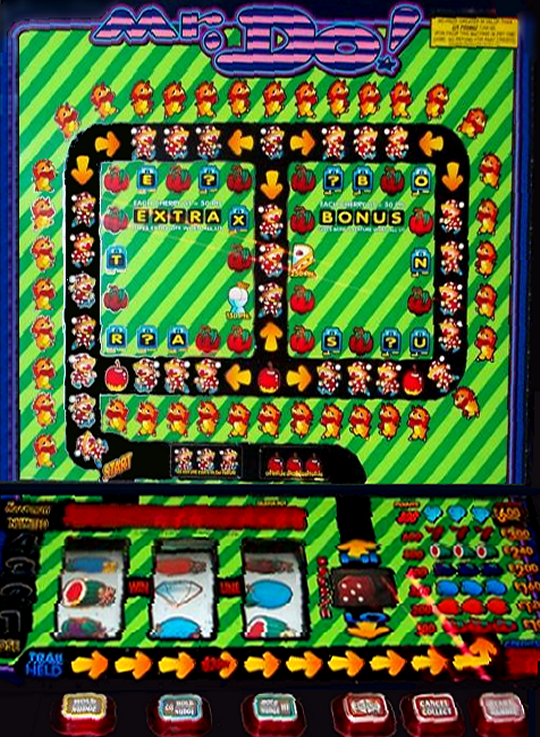
Actually,
forget that last bit – if you see a Mr Do! AWP on eBay, what you
should do is email me
immediately. You don’t want one in your home because, um, they
explode. Infamous for it, they are.
-----------------------------------------------------------------------------------------------------------
SONIC THE HEDGEHOG
As with pinball,
fruit machines skipped the second age of videogames entirely and
didn’t come back until the 16-bits took hold, although the
chronology didn’t keep pace – Sonic’s AWP, for example, came out at
more or less the same time as the Donkey Kong one. Appropriately
enough, sound is the area where it really shines – almost every spot
effect, jingle and tune is lifted straight from the videogame, with
coin deposits accompanied by an unmistakeable chorus of “SE-GA!” and
the trail-type gameboard backed by the classic Green Hill Zone
melody – but the visuals were also superb, and almost as
eye-catching to videogamers among banks of ordinary fruities as the
Mr Do! cabinet.
In gameplay terms
the Sonic board is very similar to that of Donkey Kong, a fairly
basic trail with a few ladder-type shortcuts (this time accessed by
the hi-lo reel rather than being unlocked with a Super Mario bonus),
and with the higher jackpot the gameboard is more inclined to kill
you off quickly (when fruit machines went from £4 jackpots to £6,
then £10, then £15, without increasing the price per play, they
obviously couldn’t afford to pay out as frequently). But there are a
handful of Sonic-specific hooks thrown in too, such as the
loop-the-loop feature and the collection of rings to grab the
elusive super repeater. Drop a couple of quid into this machine,
though, and you’ll be in no doubt that you’re spending a few minutes
in the Sonic universe.
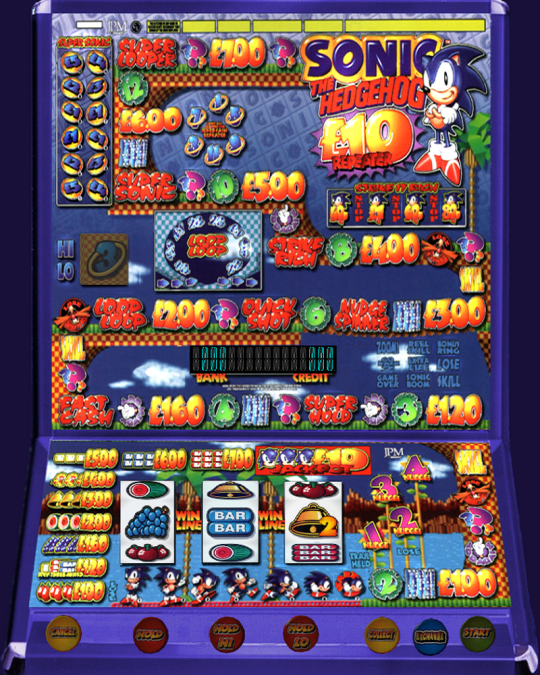
Y’know, I’ve
been playing this game for about four years, and I’ve only just
this minute noticed the “Super Sonic” bit at the top left. I wonder
what it does?
-----------------------------------------------------------------------------------------------------------
MARIO KART 64
Nintendo had
obviously been pretty happy with Maygay’s first shot at a
Mario-related fruity, and the company’s rarely-seen Mario Kart 64
AWP was an even better distillation of its source material. Perhaps
surprisingly, it doesn’t go for the immediately obvious solution of
a chase trail (with Bowser hot on Mario’s tail), but instead sees
the player zipping around
the course collecting powerups to help Mario, Yoshi and Donkey
Kong race each other towards the Super Jackpot. The MK64 gameboard
is pretty engrossing in its own right, regardless of the fact that you’re
mostly trying to win cash - it’ll take many laps to experience all
the board’s many ways of pocketing some dosh. You can profit from the reels,
the three central prize trails or the six character-based special
features, and if you can find one set to the lower jackpot values
and 5p/10p play you should get plenty of opportunities.
Aesthetically the
MK64 cabinet fits right in with its parent game, with a liberal
sprinkling of authentic sound effects and music, and the huge main
display and typefaces are instantly recognizable to any passing
gamer looking for a more enjoyable way to chuck a few quid down some
hungry bandit slots.
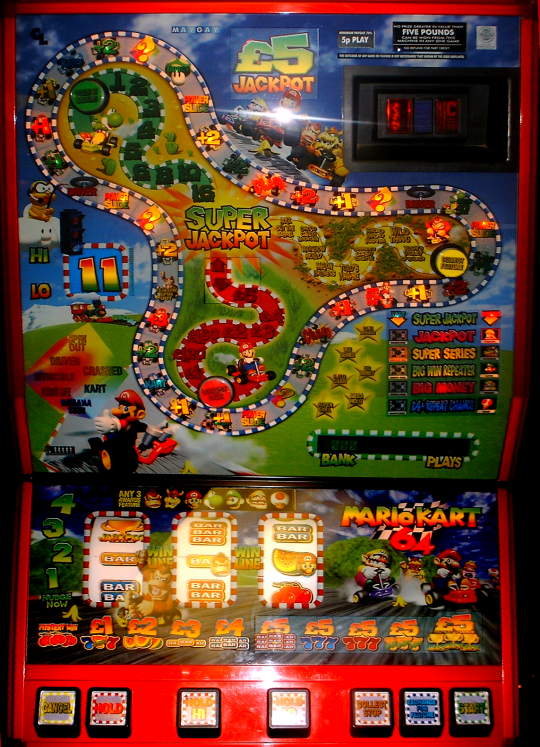
Does anyone remember
Roadkill on the Amiga? “GET THE SUPER JACKPOT!” Ah, those were the
days.
-----------------------------------------------------------------------------------------------------------
PAC-MANIA
As we’ve seen
already, poor Pac-Man hasn’t enjoyed the same luck with
fruit-machine translations as his fellow gaming luminaries, and
things didn’t improve a very great deal with the third and so far
final attempt (despite a move to yet another new publisher and
hardware standard). The Pac-Mania AWP at least adopted the most
logical chase-style gameboard, with eternal nemesis Shadow pursuing
our gaping-mawed hero towards the big money, but otherwise it was
largely the same game again as with Pac-Man and Pac-Man Plus, save
for a needlessly confusing double-trail system which detracted from
the game’s focus.
Once again, too, the
cabinet design lacked any sort of identifiable link (bar the
presence of Pac himself, of course) to the game it’s supposedly
based on. There’s absolutely nothing specific to Pac-Mania (as
opposed to ordinary vanilla Pac-Man) in either the art or the
gameplay design, and basically all you get is a totally generic
fruit machine with the Pac-Mania logo and a couple of little Pac-Man
stickers slapped haphazardly over the top. (A later £25-jackpot
model did at least triple the size of one of the Pac-Men.) The chase
aspect makes it a marginally better game than the previous two
efforts, but in the context of this feature it’s still rubbish.
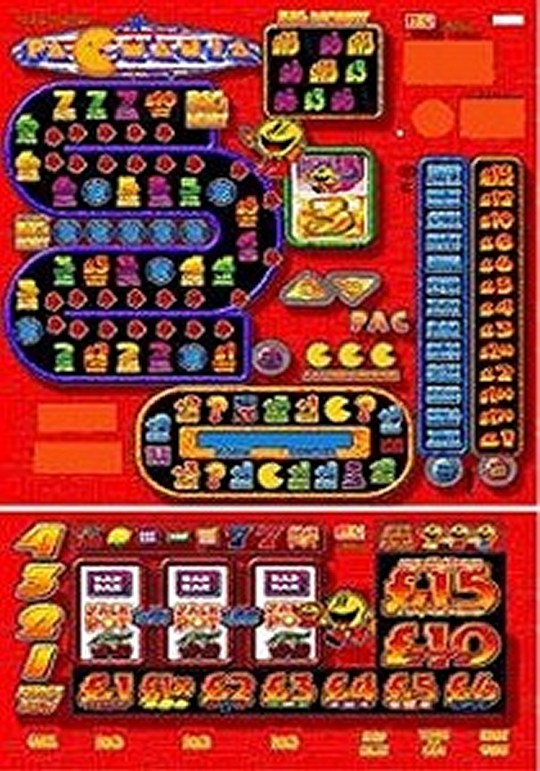
I apologise
for the poor quality of this screenshot. Everything
else that’s poor about the machine is the designers’ fault.
-----------------------------------------------------------------------------------------------------------
TOMB RAIDER
After Space
Invaders, Pac-Man, Mario and Sonic, videogaming’s biggest icon is
probably Lara Croft, and poor Lara, too, has been whored out to
almost anyone with a few quid to front up for a licence. (You really
don’t want to know about some of the indignities she’s been
subjected to in the mobile-phone market, for example.) However, the
implausibly-endowed heroine has come out of her AWP adventures
rather well. While the gameboard of Tomb Raider brings The Crystal
Maze to mind rather than any of Lara’s graverobbing escapades, it’s
one of the most complicated and involved fruit machines ever made,
and manages to simulate the feel of the videogames better than
anyone could have hoped.
You get a varying
trail to explore, weapons and items to collect, and even a health
bar to help you survive combat with various pyramid-dwelling
creatures. It even holds your hand less than most AWPs do, so you
actually have to learn your way around the reels and levels if
you’re going to have a chance of reaching the treasure. As with the
videogames, Lara’s input is limited to the occasional “Uh” and “No”,
which only increases the authenticity, and by trying to capture the
atmosphere rather than the gameplay mechanics, the JPM designers
have taken a clever and effective lateral approach.
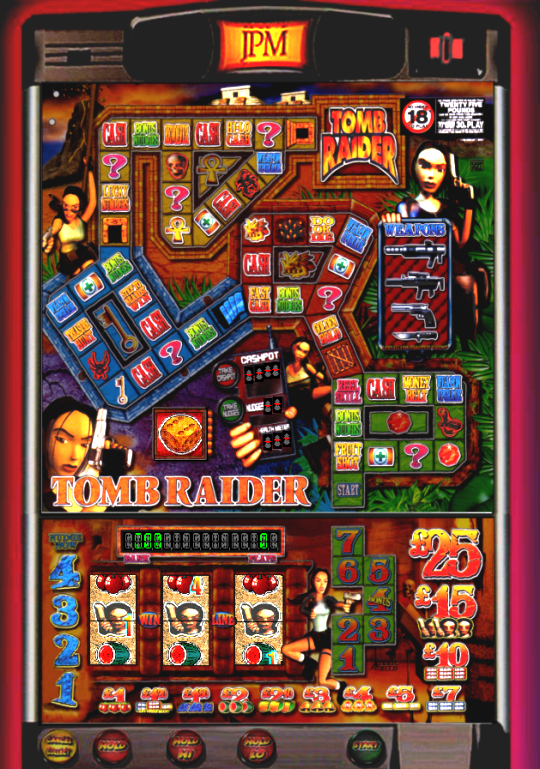
Dammit. I
should probably have saved that “bouncers” joke for this bit.
-----------------------------------------------------------------------------------------------------------
TETRIS
You might think that
something as abstract as Tetris is the sort of game that couldn’t
possibly lend itself to conversion to a fruit machine - however,
you’d be completely wrong! Wait, no you wouldn’t. Tetris is
obviously an insane choice for this sort of venture, and Mazooma’s
coders clearly threw their hands up in horror and gave up pretty
much straight away. Rather than even try to work the classic Tetris
pit into some sort of prize playfield (something which had already
been handled rather more directly in the Prize Tetris arcade game a
few years previously), this is a game that focuses, rather like Tomb
Raider, on the broader themes of the original rather than directly
replicating any of its core gameplay elements.
So you get your
favourite Tetris tunes as you Cossack-dance your way around the
gameboard, a comedy Russian announcer commentating in a sinister
accent, and the iconic pieces are reduced to collectables which,
after a fashion, form “lines” earning you guaranteed-win spins. As
AWPs go it’s not brilliant (the auto-collect features are especially
annoying), but it does have the best music you’re likely to hear in
a fruit-machine arcade, which is at least something.
And that’s about it
for our exploratory and informative jaunt through the crazy madcap world of
videogame-based fruit machines. Join us next time when we’ll be
heading into some more uncharted lands and
taking a fascinating look into the strange phenomenon of
videogame-based bubblegum scratchcards! (Or possibly won’t be. –
Ed)
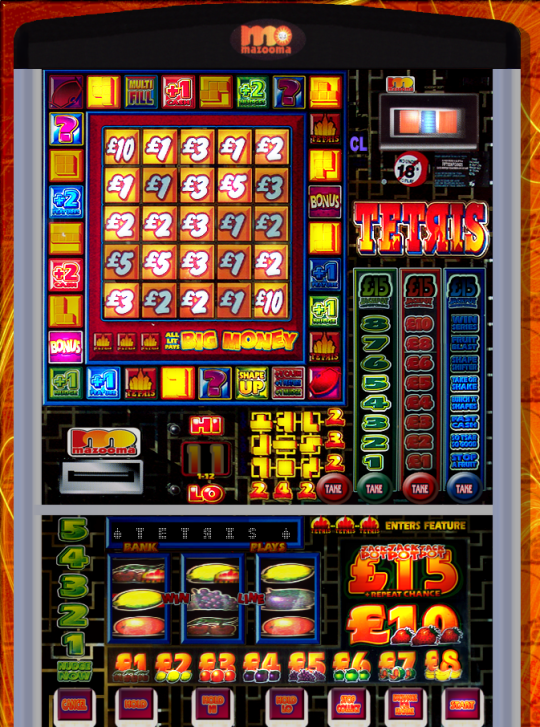
For an extra
videogame-related thrill, by holding reels two
and three you can make the comedy announcer say “Zuma”.
|
FIVE PORTIONS OF
FREE LUNCH
The
extra-specially exciting thing about the gaming age we
live in, of course, is that you no longer have to go to
arcades to play arcade games, and you no longer have to
blow a fortune to experience the gameplay discussed in
this feature. (Indeed, from a gamer’s perspective
emulation is by far the best way to explore the stuff
we’re talking about, since you can play every feature
without having to fret that you’re giving up a big win
to do it.) With the exception of Mr Do!, Pac-Mania and
Mario Kart 64, all of the games on these pages
can be enjoyed via the magical power of emulation,
specifically the AWP emus MFME and JPeMu. You can find
them, along with everything else you need to get
started, at
www.fruit-emu.com
|
*Title courtesy
of The Advertising Slogan Generator, located at: http://www.thesurrealist.co.uk/slogan.cgi
|

